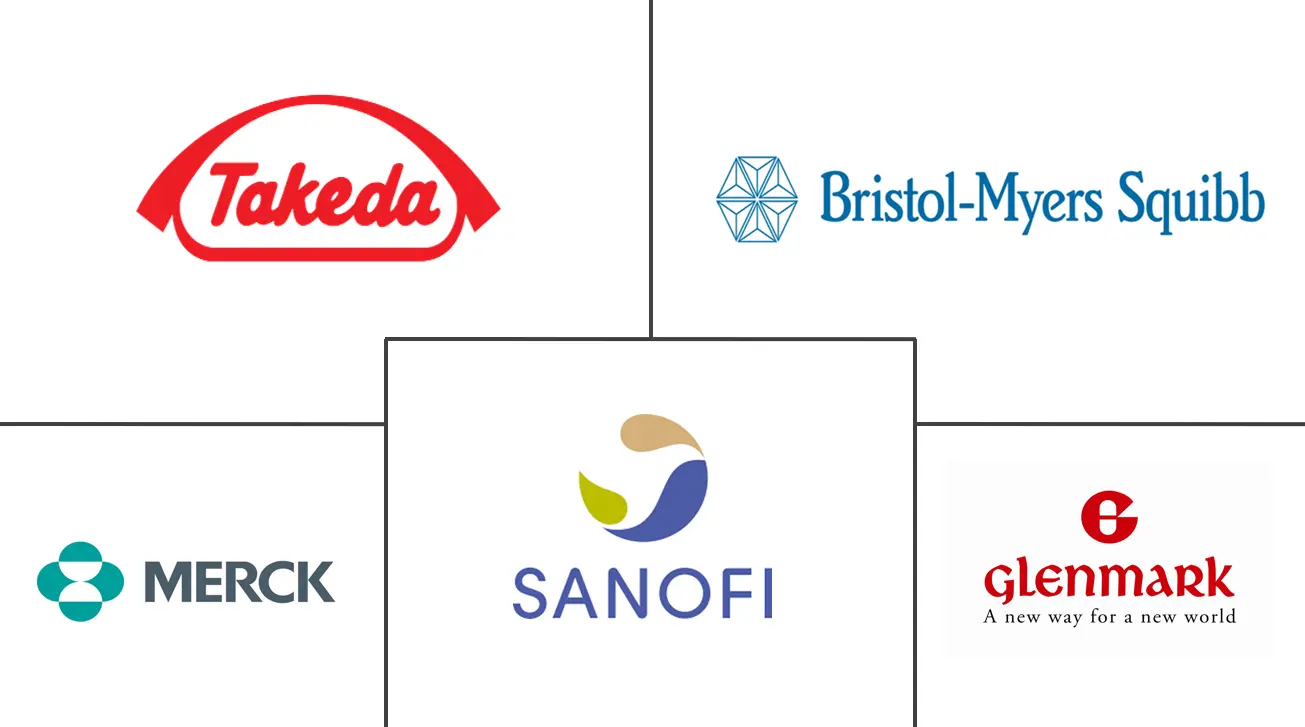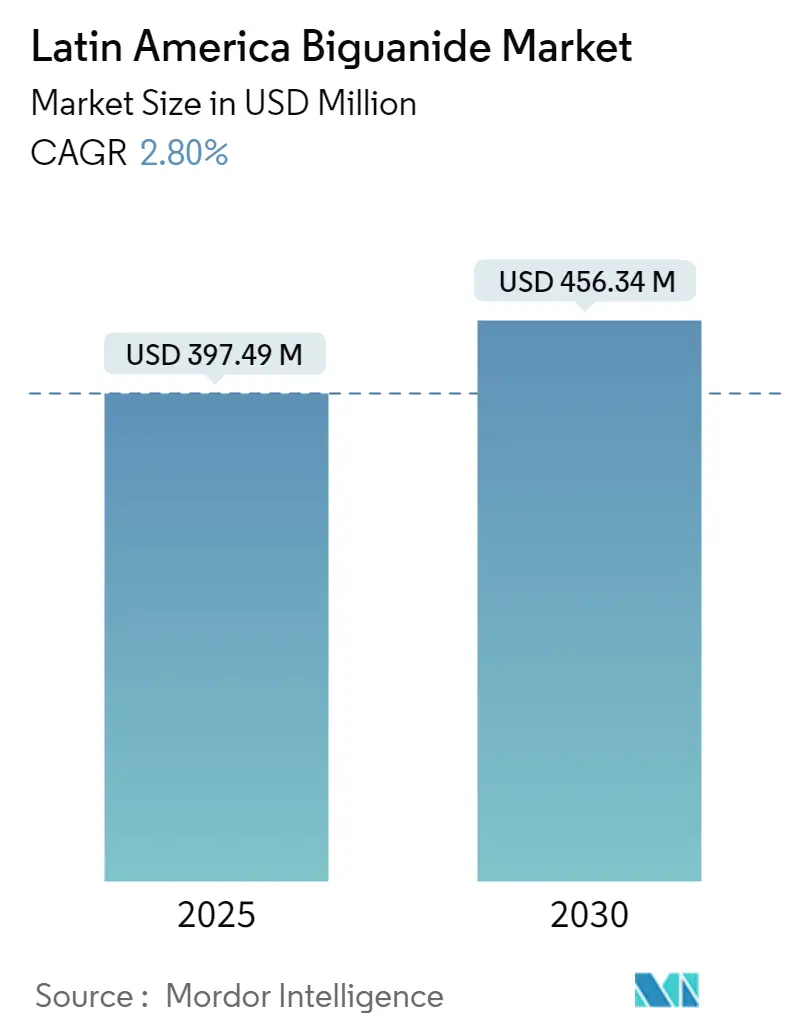
Latin America Biguanide Market Analysis by Mordor Intelligence
The Latin America Biguanide Market size is estimated at USD 397.49 million in 2025, and is expected to reach USD 456.34 million by 2030, at a CAGR of 2.8% during the forecast period (2025-2030).
Latin America is experiencing a significant surge in the prevalence of diabetes, a chronic condition that affects millions across the region. This rise in diabetes incidence has led to an increased demand for medications to manage the disease, with biguanides emerging as a cornerstone of diabetes treatment. As a result, the biguanide market in Latin America is witnessing robust growth, driven by the escalating diabetes population and the need for effective therapeutic options.
Biguanides, such as metformin, play a crucial role in the management of type 2 diabetes, the most common form of the disease in Latin America. These medications work by decreasing glucose production in the liver and improving insulin sensitivity in the body, thereby helping to control blood sugar levels. Given their effectiveness, safety profile, and affordability, biguanides have become the first-line therapy for many individuals with type 2 diabetes, particularly those in resource-limited settings.
One of the primary drivers behind the increasing demand for biguanides in Latin America is the region's changing demographic landscape. Urbanization, sedentary lifestyles, and unhealthy dietary habits have contributed to a rise in obesity rates, a key risk factor for type 2 diabetes. Additionally, an aging population and genetic predispositions further exacerbate the diabetes burden in many Latin American countries. As a result, healthcare systems are grappling with the challenge of providing adequate care and treatment for the growing number of individuals diagnosed with diabetes.
Furthermore, the economic burden associated with diabetes is substantial, both for individuals and healthcare systems alike. The costs of managing diabetes-related complications, such as cardiovascular disease, neuropathy, and nephropathy, can be considerable. Therefore, there is a growing emphasis on preventive measures and early intervention strategies, including the use of pharmacotherapy like biguanides to effectively manage the disease and mitigate its long-term complications.
Latin America Biguanide Market Trends and Insights
Rising diabetes prevalence
Diabetes reduces lifespan, and people with the disease are likely to experience blindness and be hospitalized for amputations, kidney failure, heart attacks, strokes, and heart failure. The first-line therapy used in patients with type-2 diabetes is metformin monotherapy.
When metformin is contraindicated or not tolerated, or when treatment goals are not achieved after three months of use at the maximum tolerated dose, other options need to be considered. Dipeptidyl peptidase-4 inhibitors, sodium-glucose cotransporter-2 inhibitors, and glucagon-like peptide-1 agonists are generally used to supplement treatment with metformin.
When diabetes is undetected or inadequately treated, people with diabetes are at risk of serious and life-threatening complications, such as heart attack, stroke, kidney failure, blindness, and lower-limb amputation. These result in reduced quality of life and higher healthcare costs, which lead to a greater need for access to care.
Brazil has implemented a set of reforms over the past decade to improve the distribution of doctors, develop new forms of service organization, introduce new financing models, and implement a range of quality improvement initiatives and policy frameworks to overcome risk factors such as obesity and emerging pandemic threats.
Owing to the rising rate of obesity, the growing genetic factors for type-2 diabetes, and the increasing prevalence, the market will likely continue to grow.
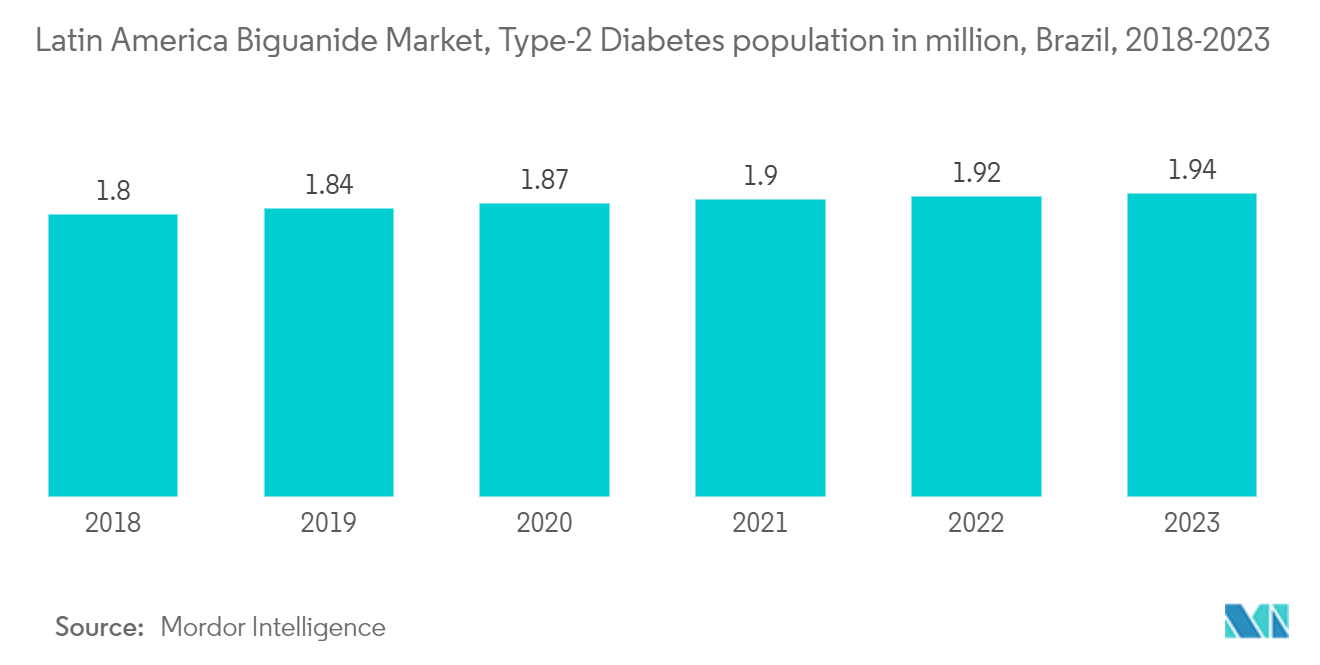
Mexico holds the highest market share in the Latin America Biguanide Market in the current year
Mexico holds the highest market share of about 46.4% in the Latin American biguanide market in the current year.
Under half of the people living with diabetes in the country are undiagnosed. Metformin is typically the first medication used in the treatment of type 2 diabetes due to its wide range of efficacy, safety, and mechanisms of action. Metformin and other anti-diabetic drug combinations have a low risk of hypoglycemia, provide beta cell protection, offer cardio-renal benefits, and are safe for patients with kidney or liver conditions and senior citizens.
Lack of health insurance deprives the poor of access to services and puts them at risk of financial hardship. To protect the people against excessive health expenditures, many countries like Mexico have implemented mechanisms such as community-based health insurance, national health insurance, and targeted public health insurance. Mexico has multiple health insurance providers. The Instituto de Seguridad y Servicios Sociales de los Trabajadores del Estado (State Employee's Social Security and Social Services Institute, ISSSTE) provides coverage for government employees, and the Instituto Mexicano del Seguro Social (Mexican Social Security Institute, IMSS) covers private-sector employees.
The Seguro Popular (People's Insurance) was launched to protect the working-age population against steep healthcare costs. Enrollment in the Seguro Popular is independent of health status or pre-existing illness; there is no co-payment in accordance with the type of health care received; and family contributions are determined solely by the ability to pay. The Government of Mexico partnered with numerous private companies to utilize their supply chain (manufacturing, distribution, and retailers) to ensure low prices for drugs.
The aforementioned factors are expected to drive the market's growth.
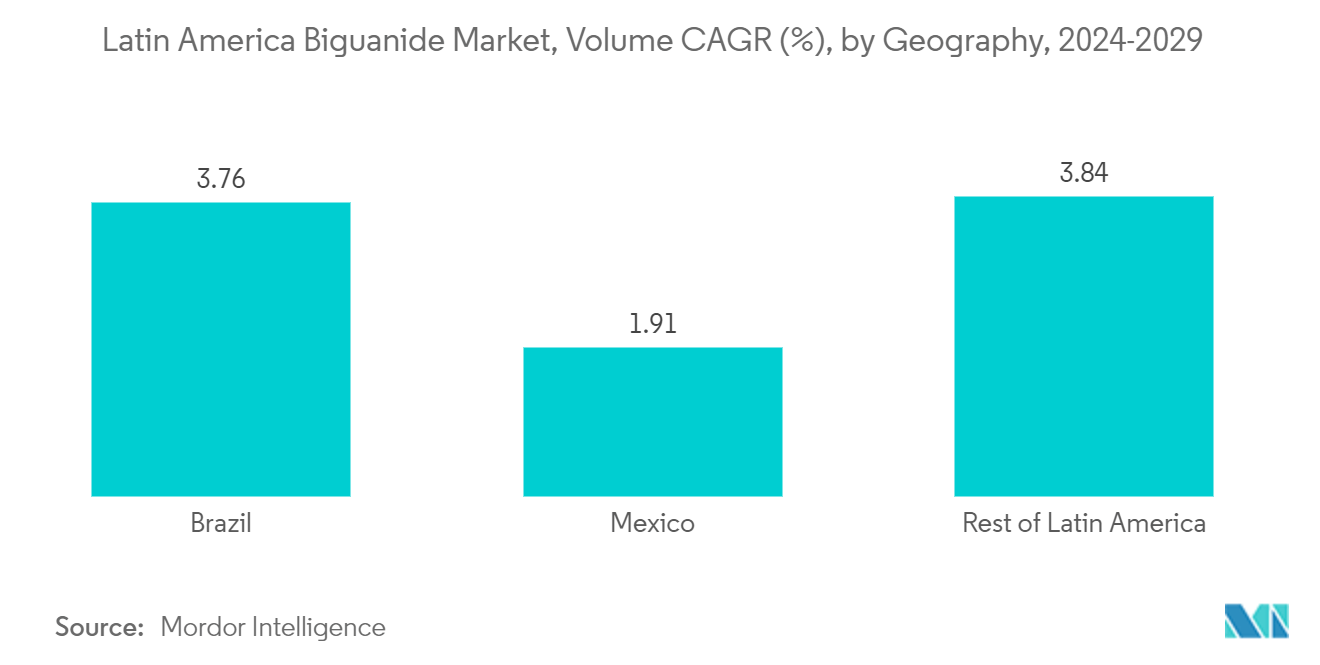
Competitive Landscape
The Latin American biguanide market is fragmented, with manufacturers like Takeda, Merck, Sanofi, GlaxoSmithKline, Bristol-Myers Squibb, Boehringer Ingelheim Pharmaceuticals, etc. having a global market presence, and the market is highly competitive due to generic drug manufacturers' presence.
Latin America Biguanide Industry Leaders
Bristol-Myers Squibb
Boehringer Ingelheim
Merck and Co.
Sanofi Aventis
Glenmark Pharmaceuticals
- *Disclaimer: Major Players sorted in no particular order
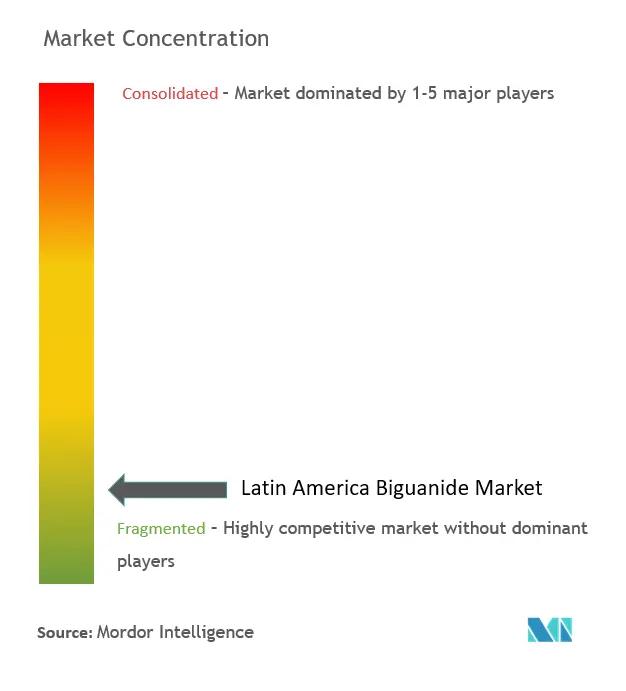
Recent Industry Developments
- February 2023: Zydus Lifesciences Limited, received tentative approval from the FDA for Invokamet tablets (canagliflozin and metformin hydrochloride combination). Canagliflozin and metformin combination products are indicated as an adjunct to diet and exercise to improve glycemic control in adults with type 2 diabetes mellitus who are not adequately controlled on a regimen containing metformin or canagliflozin or in patients already being treated with both canagliflozin and metformin.
- July 2022: Zydus Lifesciences announced that it received final approval from the FDA to market Empagliflozin and Metformin Hydrochloride tablets in multiple strengths. Empagliflozin and Metformin Hydrochloride tablets are used with proper diet and exercise to improve glycemic control in adults with type 2 diabetes mellitus. They are also used to lower the risk of cardiovascular death in patients with type 2 diabetes mellitus and established cardiovascular disease.
Latin America Biguanide Market Report Scope
Biguanides are a class of diabetes medications that are used for people with type-2 diabetes. The Latin American biguanide market is segmented by geography. The report offers the value (in USD) and volume (in units) for the above segments. Further, the report will cover a segment-wise breakdown (value and volume) for all the countries covered under the table of contents.
| Mexico |
| Brazil |
| Rest of Latin America |
| Geography | Mexico |
| Brazil | |
| Rest of Latin America |
Key Questions Answered in the Report
How big is the Latin America Biguanide Market?
The Latin America Biguanide Market size is expected to reach USD 397.49 million in 2025 and grow at a CAGR of 2.80% to reach USD 456.34 million by 2030.
What is the current Latin America Biguanide Market size?
In 2025, the Latin America Biguanide Market size is expected to reach USD 397.49 million.
Who are the key players in Latin America Biguanide Market?
Bristol-Myers Squibb, Boehringer Ingelheim, Merck and Co., Sanofi Aventis and Glenmark Pharmaceuticals are the major companies operating in the Latin America Biguanide Market.
What years does this Latin America Biguanide Market cover, and what was the market size in 2024?
In 2024, the Latin America Biguanide Market size was estimated at USD 386.36 million. The report covers the Latin America Biguanide Market historical market size for years: 2019, 2020, 2021, 2022, 2023 and 2024. The report also forecasts the Latin America Biguanide Market size for years: 2025, 2026, 2027, 2028, 2029 and 2030.
Page last updated on:
Latin America Biguanide Market Report
Statistics for the 2025 Latin America Biguanide market share, size and revenue growth rate, created by Mordor Intelligence™ Industry Reports. Latin America Biguanide analysis includes a market forecast outlook for 2025 to 2030 and historical overview. Get a sample of this industry analysis as a free report PDF download.
